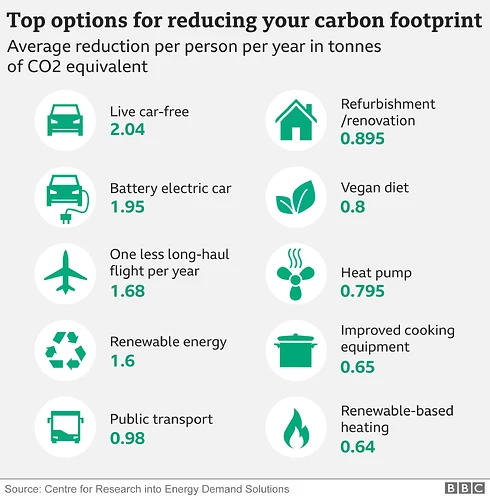Whilst climate change news is always at the forefront of media & newspapers, with the new often seeming bleak, here is 6 ways you can realistically reduce your own carbon footprint. As well as an infographic from the BBC’s centre for research into energy demand solutions:
Fewer flights
Groundbreaking change in emission reduction can occur if flights worldwide were halted, instantly ceasing at least 2.5% of CO2 emissions. The aviation sector, contributing one billion tonnes of CO2 annually, witnessed a 30% increase from 2013 to 2019. Although a complete flight ban is unfeasible, decreasing flight demand is achievable. Embracing alternatives like train or bus travel, opting for economy class, and exploring alternative fuels for aircraft contribute significantly to emissions reduction.
Food
The shift to a plant-based diet can save approximately 0.8 tonnes of CO2e annually. A global transition to plant-based diets could liberate 75% of agricultural land for diverse ecosystems. Even partial shifts, such as choosing lower-carbon food options, contribute to emission reduction. Addressing food waste, totaling 900 million tonnes annually, offers substantial emissions savings, emphasizing the importance of conscious dietary choices.
Transport
Private transport stands as a major greenhouse gas emitter, surpassing other sectors in countries like the UK and the US. Simple measures, such as reducing car usage for short distances and opting for walking or biking, significantly cut carbon footprint. Public transport, for longer journeys where available, emerges as a lower carbon alternative, showcasing the impact of sustainable commuting choices.
In the home
Homes contribute significantly to emissions, with heating accounting for a substantial portion, particularly in regions relying on fossil fuels. Modest adjustments, like thermostat settings and judicious air conditioning use, can lead to emissions reduction. Technological solutions, such as heat pumps, offer a carbon-neutral heating alternative. Sustainable practices like cold-water washing and air-drying clothes contribute further to household emissions reduction.
Finance
Financial decisions wield a powerful influence on combating climate change, with many banks implicated in financing the climate crisis through fossil fuel extraction. While consumer banking arms are typically separate from investment arms, the choice of ethical banks or alternatives like credit unions can align with climate-conscious values. Additionally, pension investments, often overlooked, directly influence the global economy. Aligning pension investments with sustainability goals offers a direct avenue for individuals to contribute to emission reduction.
Fashion
The fashion industry, responsible for 8-10% of global carbon emissions, presents opportunities for sustainability. Embracing second-hand clothing, whether from thrift shops, online platforms, or renting, diminishes the environmental impact of fast fashion. Beyond purchasing choices, reducing washing frequency helps lower the carbon footprint of one’s wardrobe and minimizes microplastics entering waterways. Responsibly managing clothing at the end of its life by passing items on, selling them online, or utilizing second-hand shops fosters a circular and sustainable fashion economy.
